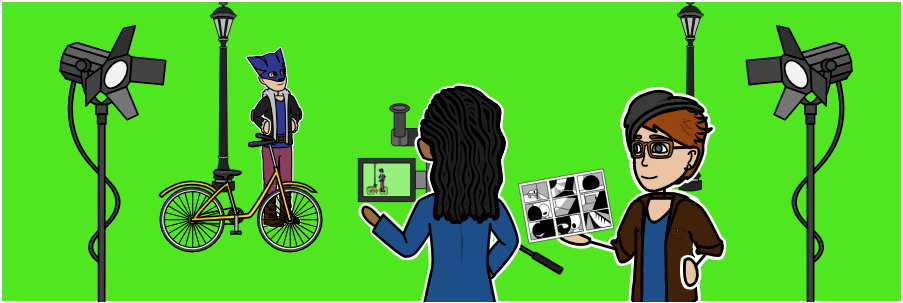Screenplay to Storyboard

Filmmaking begins from the first time you dream. That can be the sleeping kind of dream, or the daydream, where your imagination takes you to amazing places. In both cases, there’s a picture in the mind’s eye. And for the moment, nobody in the world but you can see it. In that way, we are all filmmakers. But what separates the bonafide filmmaker from everyone else is their need to turn those dreams into an actual movie. And that means getting down to the hard work of bringing those visions to life.
The script comes first – that sweet & complete final draft is the first mile marker on your journey. From here forward, just about everything in the creative process becomes solid reality. The actors are real, the props are hard and soft, the wardrobe’s stitching pops, you stand in the locations and breathe the air. But before all that, the very first visualization of your film will be the video storyboard.
Storyboards are essentially sequential art – like comic books – which show the linear progression of a film’s action as described in the script. While a screenplay will give certain key visual instructions, it’s not meant to show every single shot, every camera movement, every close-up or every edit. Sure, the important stuff will be pointed out, things that matter to the progress of the narrative. But if every single bit of direction was laid into a script, it would read like stereo instructions.
It’s the storyboard’s job to realize a graphic representation of the film’s sequential progress. Think of it as a slideshow of the entirety of the project that’s drawn rather than photographed. A well-prepared film production will use a storyboard to plan pre-production, keep it at hand on set, and refer to it during the editing process.
But how do we generate one of these wonderful filmmaking tools? We start right where the filmmaking process began: in the mind’s eye. You can see your viral YouTube video already, can’t you? From there, a little organization and guidance can take you to the storyboard.
Here are my step-by-step instructions for getting it done. I’ve divided the steps into two halves – the basics for getting started, and creative guidelines for bringing out the vision. Use them as you will – it’s not the only way to do things – but these tips and suggestions should help you get the job done.
Identify Your Scenes
Storyboarding the typical 90-120 pages of a feature length movie is a long and arduous process. Even producing the 30-second commercial may command great effort on the filmmaker. That’s why scenes need to be broken down into chunks first. Separate the scenes out and work them piecemeal as you assemble the larger overall work.
But how do we identify “a scene” anyway? It can be trickier than you think. Scenes are initially defined by two things: place and time. From there comes context, which can incorporate or transcend those two elements.
Consider Alice in Wonderland as an example. They story starts with Alice looking bored taking lessons from her sister in a garden. She then sees a rabbit with a watch. The curious girl pursues the rabbit down a path. Finally, she follows him down a hole, into which she falls. While technically, there’s a few different places in this sequence, it’s in the same basic stretch of time, outside in the garden, and we could call all of this together a scene.

However – once Alice falls into the hole, she’s in a totally different reality. Is this a good place for a scene break? Even if we’re in the same stretch of uninterrupted time? Yes, because the context is totally changed now. No longer in an ordinary pastoral English scene, our heroine is floating through a surreal landscape of upside-down worlds and mad visions. Our places have totally shifted and that means a new page for the storyboard artist. So:
- Alice, Scene 1 – Chasing the Rabbit through the garden.
- Alice, Scene 2 – Alice falling into the world of the hole.
But now let’s look at the problem of montage. Possibly the most famous montage ever is the classic scene in Rocky, where the boxer is training to the uplifting theme music. We see Rocky punching the bag, Rocky skipping rope, and of course, Rocky running down the street with a million kids chasing after him.

Are each of these frames a new scene? Of course not. Even though the elements of the montage are set in totally different places at totally different times, all of these together are a scene.
At the end of the day, there has to be a “feel” to defining a scene. This sensation can reflect many qualities. Thematic, inductive, sequential, change of scene, change of pace and many more “markers” can create the border between scenes. As a film viewer, you have witnessed these transitions many times. As a filmmaker, you will uncover them.
A final note on this step: this is NOT to be confused with a script breakdown! That’s a whole other ball of wax. You can read all about in our article on preproduction.
List Your Shots
This is pretty basic. Once you’ve identified the scenes, organize them into a single document, in the absolute chronological order as they would appear on screen after your final edit. You can scratch this on paper or in a Word document, but a digital spreadsheet is advised, as it can be built into something bigger you can use in pre-production and while you shoot: a pre-production shot list. Again, that’s something else you can read about in the preproduction article. In any case, keep this one simple. It’s just a reference tool to visualize your storyboard from, albeit a very important one.
Break the Scene Down
Now that you’ve got your templates set up, time to get to work. Here’s where the filmmaker really needs to employ the imagination. The trick here is to see the edit of the film before a frame is shot. Each storyboard cell should correspond to how the filmmaker anticipates the camera will be viewing the action, and any significant motion that either the camera or the scene’s inhabitants will be making. Grab your script and study the scene. Conjure up what your assembled shots will flow like. Will the camera be changing angles? Will there be motion of a character or prop? Will the location change?
Let’s go back to Alice vs. Rocky.
With Alice, the breakdown of the Rabbit scene might look like this:
- Long Shot of a garden, Alice laying down looking bored; sister reading.
- Close Up Alice – a look of surprise on her face.
- Angle on Rabbit – a new angle reveals a white rabbit with a watch.
- Tracking Shot – Alice runs towards the Rabbit.
- Zoom In on the hole as the Rabbit Jumps into it.
- New Angle – Alice follows, leaping into the hole herself.
The filmmaker will take each of these beats and draw the images into each cell in sequence. This storyboard page will be six panels, or about a page long.
With the Rocky montage, we are looking at maybe dozens of shots, stretching across pages of storyboard cells. It’s the punching bag, the rope skipping, the running. But it’s also a whole bunch of different parts of the city he’s running in, and at different times of the day. There’s the rope skipping as a full shot in the gym, and as another shot done as a close up of Rocky’s feet. And so on.
So, six storyboard panels for Alice’s rabbit encounter on one page. And maybe 40 panels for Rocky’s montage over 8 pages of storyboard. Both scenes will be about a minute long on screen. What makes the lengths of the process different is dictated by the storyboarding needs of the script and filmmaker.
OK, now that you know the basic “how-to” of the storyboard process, we can move on to the important creative approach. This will mark the first time you become the filmmaker as artist in visual terms. The style of your camera, the assemblage of your editing scheme, the motifs and feel will be fleshed out. Time to learn how you make your film truly YOURS.
About the Author

Argentinean-born New Yorker Miguel Cima is a veteran of the film, television, and music industries. An accomplished writer, filmmaker, and comic book creator, Miguel's movie, Dig Comics, won Best Documentary at the San Diego Comic Con and was selected for Cannes. He has worked for Warner Bros. Records, Dreamworks, MTV, and more. Currently, Miguel creates content for multiple platforms and media. His formal education came from New York University, where he earned a BFA in film. World traveler, culture junkie and major foodie, he is happily unmarried to the same gal since the mid 2000s, devoted to his family & friends, and slavishly serves his true masters - two dogs and a cat.
© 2025 - Clever Prototypes, LLC - All rights reserved.
StoryboardThat is a trademark of Clever Prototypes, LLC, and Registered in U.S. Patent and Trademark Office

